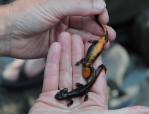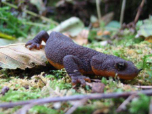 |
Crater Lake Newt Range Map
|
|
|
 |
 |
 |
 |
 |
 |
 |
Crater Lake Newt Juvenile
Want to Contribute a photo of a Juvenile Crater Lake Newt?
Email Us
|
|
|
 |
 |
 |
 |
 |
 |
|
Crater Lake Newt (Taricha granulosa mazamae)
Description: Larvae are aquatic, with a faint dorsal stripe on either side of the body that fades as they mature. Larvae have a dark stripe that extends from the eye to the nostril as well as two rows of spots. One row is near the limb insertions and the other is near the fin. The fin is speckled with dark spots. Larvae measure around 18 mm in total length.
Adults range from about 12.7 to 21.6 cm in total length. They have rough, grainy skin that is dark-colored dorsally and orange to yellow-orange ventrally. Their textured skin has earned them the common name "rough-skinned newts." Their eyes are relatively small and do not extend beyond the edges of the head. The irises are yellow, and the lower eyelids are orange. The vomerine teeth are arranged in a V-shaped pattern. Costal grooves are absent. Males are larger than females, with longer vents. During the breeding season, males and females become temporarily aquatic. Males develop smooth, spongy skin that is lighter-colored than usual. Their vents are strongly pronounced and swollen. The tail crests become more pronounced, as do the nuptial pads on the tips of their toes. The appearance of the females does not change, though their vent becomes cone-shaped.
Some adults living at high elevations retain their gills and are totally aquatic, though they do not exhibit genuine paedomorphosis. Aquatic females can sometimes be confused with breeding males, because they have lighter, smoother skin, tail crests, and larger vents than do terrestrial females. However, these features are less pronounced than in breeding males.
Habitat: Taricha granulosa inhabits both aquatic and terrestrial environments. Though they generally spend more of their time on land, they must return to the water to breed. Many become temporarily aquatic during the summer months due to dry weather. It is possible for a newt to spend its entire life in an aquatic habitat. In the water, T. granulosa prefers areas of little or no current, such as ponds, lakes, and slow-moving streams, and sometimes small ephemeral wet areas such as ditches. Aggregations of adults have been discovered as deep as 12 meters underwater. On land, newts can usually be found under pieces of rotting wood on forested hills or mountains.
Range: Found only in Crater Lake, Oregon.
Found in these States:
OR
Diet: Larvae eat small aquatic invertebrates. Aquatic adults have been known to eat a variety of organisms, from snails and insects to other amphibians. Adult terrestrial T. granulosa appear to be opportunistic carnivores, with insects making up a large portion of their diet.
Reproduction: Breeding takes place underwater, and is initiated by the male. He climbs on top of the female, clasps her with his legs, and proceeds to rub the snout of the female with his chin while stroking her legs with his hind legs. This behavior is known as amplexus, and can last anywhere from several hours to two days. The male then releases the female, crawls in front of her, and deposits a spermatophore, which is a gelatinous mass with a small capsule of sperm at the top. The female picks up the sperm capsule with her cloaca (vent). In some instances other males will attempt to separate an amplexed pair.
Reproduction in T. granulosa is totally aquatic, usually occurring in still or slow-moving waters near vegetation. The breeding season is highly variable depending on elevation. At lower elevations, most reproductive activity occurs in the spring, from January to May. At high elevations, most breeding occurs during late summer and early fall. Females lay their eggs soon after mating. The eggs are laid one at a time and are attached by the female to vegetable matter or detritus. They take 3 to 4 weeks to hatch.
Status: The Crater Lake newt population is under threat due to predation from crayfish and rainbow trout that have been introduced into the lake.
Taxonomy: Although no subspecies of Taricha granulosa are recognized, populations within Crater Lake, Oregon, are sometimes treated as a distinct subspecies, Taricha granulosa mazamae.
»» Kingdom: Animalia - Animals
»» Phylum: Chordata - Chordates
»» Subphylum: Vertebrata - Vertebrates
»» Class: Amphibia - (Amphibians)
»» Order: Caudata - Salamanders
»» Family: Salamandridae - Newts
»» Subfamily: Pleurodelinae - Pleurodeline Newts
»» Genus: Taricha
»» Species: Taricha granulosa - Rough-Skinned Newt
»» Subspecies: Taricha granulosa mazamae - Crater Lake Newt
This article uses material from the Wikipedia article "Crater Lake Newt", which is released under the Creative Commons Attribution-Share-Alike License 3.0. Content may have been omitted from the original, but no content has been changed or extended.
|
|









